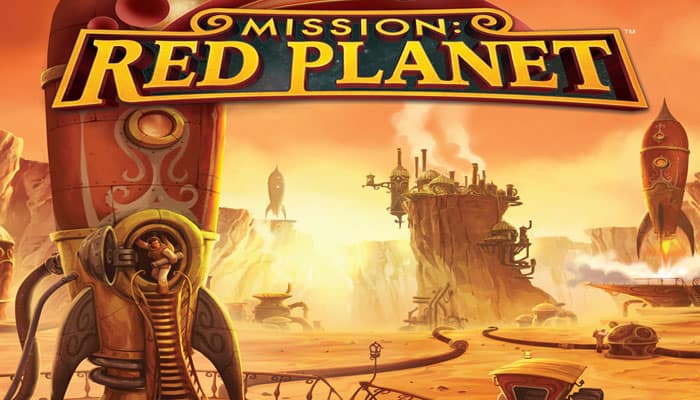
In Mission: Red Planet, two to six players assume the roles of Mars-bound mining corporations in a Victorian steampunk era. Players send astronauts to explore various zones of Mars, compete for majority in their zone, and mine the planet's valuable resources.
Object of the Game
Players can gain points in several ways, such as by mining resources and completing mission cards. At the end of the game, the player with the most points wins.
Components

- 1 Game Board of Mars consists of 4 pieces
- 1 Moon of Phobos
- 1 Lost in Space Memorial
- 132 Plastic Astronauts (22 for each color)
- 1 Round Tracker
- 11 Resource Tokens
- 20 Destination Tokens
- 86 Point Tokens
- 36 Ship Cards
- 54 Character Cards
- 1 Global Mission Card
- 30 Event Cards
Setup
Setup Diagram (4-player Game)

-
Prepare Game Board: Connect the four pieces Tf) of Mars and place the assembled planet in the center of the play area. Place Phobos and the Lost in Space Memorial near Mars.
-
Construct Launchpad: Connect dock pieces so that there are a number of docks equal to the number of players. Use the end cap docks for the left-most and right-most docks of the launchpad.
-
Prepare Supply: Place the destination tokens within reach of all players, and sort the point tokens into piles by type. Place the "Ice Monopoly" global mission card faceup near the supply.
-
Prepare Ships: Shuffle the ship cards to create the ship deck and place it near the launchpad. Draw a number of ship cards equal to the number of players in the game and place them faceup, one ship at each dock of the launchpad.
If a drawn ship has an unknown destination, replace it with a new card, shuffling the unknown destination ship back into the ship deck. If a Phobos-bound ship has not been drawn, place a Phobos destination token on the ship at the right- most dock.
-
Choose Colors: Each player chooses one color to use for this game. He gathers the nine character cards and all of the plastic astronauts of that color. His starting hand of cards contains all nine of his character cards.
-
Place Starting Astronauts: Take one astronaut from each player and randomly place one on each ship at the launchpad. The player whose astronaut is on the left-most dock is the first player and takes the round tracker, setting it to "1".
-
Place Resources: Randomly place one resource token facedown in each zone of Mars and on Phobos. There will be one resource token remaining, which is placed facedown near the supply.
-
Deal Starting Mission: Shuffle the mission cards and deal two cards to each player. Each player chooses one card to keep, placing it facedown in his play area, and places the unchosen card facedown on top of the undealt mission cards. Chosen mission cards remain hidden from other players until the end of the game.
-
Create Event Deck: Shuffle the discovery cards, the action cards, and all remaining mission cards together to create the event deck and place it facedown near the token supply.
Game Play
The game is played over a series of rounds, with a few different phases occurring in between certain rounds. The round tracker displays the order in which the rounds and phases occur.
There are 10 rounds during the game, each indicated by a number on the round tracker. During a round, each player secretly chooses one character card from his hand and, later in the round, resolves its effect. Each character card has a unique effect, such as placing astronauts on ships, drawing event cards, or even destroying a docked ship.
A round consists of these six steps:
- Choose Character
- Resolve Character Effects
- Land Launched Ships
- Draw New Docked Ships
- Assign New First Player
- Advance Round Tracker
1. Choose Character
Each player simultaneously chooses one character card from his hand and places it facedown in front of him. When all players have chosen their card, continue to the next step.
2. Resolve Character Effects
During this step, players reveal and resolve their characters' effects, and docked ships can become full and launch.

Each character card has a number in the upper-left corner of the card, which determines when the card is revealed. The first player begins reciting the "countdown to blastoff" announcing each character number starting with the number "9" (the Recruiter).
Each player whose facedown card matches the announced character number reveals it, flipping it faceup, and resolves its effect. If two or more players reveal the same character, they resolve their character's effect in clockwise order, starting with the first player.
After all players who revealed the announced character have resolved its effect, or if no player chose the announced character, the first player continues reciting the countdown by announcing the next character in descending order, and so on until all players have revealed their chosen character cards.
When resolving character effects, they must be resolved from top to bottom in the order written on the card. Played character cards remain faceup in front of the owner and visible for all players to see.
Note: Once a character is used, it cannot be used again until the player plays the Recruiter card, which returns all of his played cards to his hand.

A ship is full when the number of astronauts on it is equal to its capacity number. When a docked ship becomes full, it launches. The first player slides the ship card away from the launchpad to indicate that the ship has launched (see images below).

Ships launch only if they become full or due to a game effect, such as the Secret Agent. Ships that are not full stay docked at the launchpad.
3. Land Launched Ships
Each launched ship lands on Mars, unloading all astronauts aboard that ship in the indicated zone. If there is a destination token covering the destination printed on the ship card, the ship instead lands in the zone indicated on the token.
When an astronaut is placed in a zone with a facedown resource token, the resource token is flipped faceup, revealing which resource is present in that zone.
After landing a ship, place it faceup next to the ship deck in the ship discard pile. If it had a destination token, return it to the supply.
4. Draw New Docked Ships
During this step, new ships are docked at the launchpad. For each open dock at the launchpad, the first player draws one ship card and places it faceup at an open dock. If the ship deck is depleted, shuffle its discard pile and place it facedown to create a new deck.
5. Assign New First Player
The player who resolved his character effect last during this round takes the round tracker, becoming the new first player.

6. Advance Round Tracker
The first player slides the gauge clockwise until the pointer lines up with the next notch. The icon visible in the window indicates which round or phase occurs next.
Production Phase
In the game there are three production phases indicated on the round tracker. During a production phase, each zone with a faceup resource token produces point tokens of its resource type equal to the number of dots shown in the production phase icon.

Then, players receive point tokens based on majority in each zone. If only one player has the most astronauts in a zone, he receives all the point tokens from that zone. If two or more players tie for the most astronauts in a zone, the tied players evenly distribute the point tokens from that zone.
Any remaining point tokens stay in the zone and can possibly be won at a later time. If there are no astronauts in a zone, the point tokens stay in that zone.
At the end of each production phase, the first player advances the round tracker to the next notch.
Example: There are two players tied in a zone with three point tokens, so the two tied players each receive one of those point tokens, and the third point token stays in the zone.
Example: There are three players tied in a zone with two point tokens, so the three tied players do not receive any of those point tokens, and those tokens stay in the zone.
Reveal Discovery Phase
The first player flips all discovery cards in play faceup. Each discovery card effect; resolves duping the phase indicated by the icon in the lower-right corner of the card, as shown below.

At the end of the reveal discovery phase, the first player advances the round tracker to the next notch.
Final Scoring Phase
Players reveal their mission cards and determine if they were completed. The player(s) with the most ice point tokens gain points for completing the "Ice Monopoly" global mission. Then, each player calculates his final score as follows:
- He adds points from his completed missions.
- He adds the total value of all his collected point tokens.
- He adds or subtracts points from discoveries that affect him.
Players compare final scores, and the player with the highest score wins the game. In case of a tie, the tied player who has the largest quantity of point tokens (regardless of value) wins the game. If there is still a tie, the tied players share the victory.
Event Cards
There are three types of event cards: discoveries, missions, and actions. Event cards are drawn when dealing starting missions during setup and by the Scientist's effect

Discoveries are scientific phenomenons or geographical features that can be found on Mars. When a player draws a discovery card, he assigns it facedown to any outer zone of Mars by physically sliding a portion of the card under the board. At the end of the game, discovery cards provide either a positive or negative effect (e.g., that zone produces more point tokens).
Missions are secret objectives that award points to the owner if he completes them. When a player draws a mission card, he looks at it and keeps it facedown in his play area. It remains hidden until the final scoring phase.
Actions are special effects that can occur at different times in the game. When a player draws an action card, he looks at it and keeps it facedown in his play area. He keeps it hidden until the text specifies when to play it.
Destination Tokens

Destination tokens are used by the Pilot's effect and by the player who places the first astronaut in a ship with an unknown destination.
When either of these situations occur, the active player takes any destination token from the supply and places it on top of the ship's printed destination. This ship is now bound for the destination printed on the token.
The destination token supply is limited to two tokens per zone. When a ship with a destination token lands, return the token to the supply.
Lost In Space Memorial
The Lost in Space Memorial enshrines the valiant astronauts who died at some point during their Martian expedition. The Femme Fatale and Soldier effects directly kill astronauts, who are then sent to the Lost in Space Memorial. Also, any astronauts aboard a docked ship that is destroyed by a Saboteur are killed and sent to the Lost in Space Memorial. The Lost in Space Memorial is not a zone.
Phobos
Phobos acts as an outpost for colonists headed to Mars. Phobos behaves like the other zones on Mars except that it is not adjacent to any other zone and discovery cards cannot be assigned to it.
Ice Monopoly Mission
The "Ice Monopoly" mission is a global mission, meaning it can be completed by any player. During final scoring, the player with the most ice point tokens has completed the mission and gains 9 points. In case of a tie for the most ice tokens, the tied players divide the 9 points among them (rounded down).
Card Clarifications
This section addresses rule questions that may arise during the game.
Character Cards
-
All character effects are mandatory and must be fully resolved, if possible. If it is not possible to fully resolve the effect, then it should be resolved as fully as possible. The Travel Agent's effect, which must be fully resolved or not at all, is the only exception to this rule.
-
A player must fully resolve his character's effect before any full ships can launch.
Example: The red player chooses the Saboteur. When he reveals it during the next step, there is only one docked ship at the launchpad. He must place one of his astronauts on the docked ship, which becomes full. Then, he must destroy that ship before it launches.
-
9 Recruiter: The player takes all of his played character cards back into his hand, including the Recruiter card.
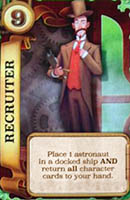
-
8 Explorer: To make a move, the player moves one of his astronauts from its current zone to an adjacent zone. The same astronaut can be moved multiple times. When a player moves an astronaut to a zone with a facedown resource token, he flips that token faceup.

-
7 Scientist: After looking at a facedown discovery card, the player returns it facedown to its assigned zone. If all outer zones already have a discovery card assigned to them and the player draws a discovery card, he discards it faceup next to the event deck and looks at a facedown discovery card in play.

-
6 Secret Agent: The player can force a ship that has zero astronauts on board to launch.
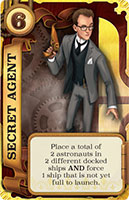
-
5 Saboteur: All astronauts on a destroyed ship are killed and placed on the Lost in Space Memorial, and then the destroyed ship is discarded.
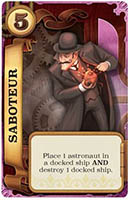
-
4 Femme Fatale: The "replace" effect can target astronauts in a docked ship, a launched ship, or any zone of Mars (including Phobos) in which at least one of his own astronauts is already present. The replaced astronaut is killed and placed on the Lost in Space Memorial.
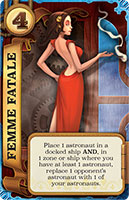
-
3 Travel Agent: If there is not a docked ship with room for at least three more astronauts, the player ignores this effect and skips his turn.
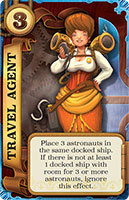
-
2 Soldier: The "kill" effect can target astronauts in any zone except Syrtis Major and Valles Marineris. A player can kill his own astronauts. Astronauts that are moved at the same time are not required to go to the same zone. The player must move at least one astronaut.

-
1 Pilot: The "place a destination token" effect can target either a docked ship or a launched ship. Destination tokens can be placed on top of other destination tokens, thus changing that ship's destination again.

Event Cards
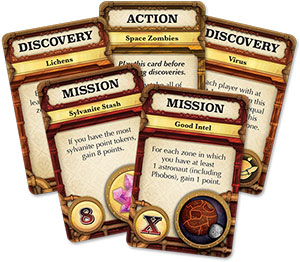
Action Cards
Action cards are kept hidden together with mission cards.
Discovery Cards
-
Discovery cards can be assigned to any zone except Phobos, Syrtis Major, and Valles Marineris.
-
Each zone (including Tritonis Sinus) can have at most one discovery card assigned to it, and assigned discovery cards cannot be removed, overridden, or replaced.
-
Discovery cards have effects that can resolve when revealed (during the reveal discovery phase), during the third production phase, or during the final scoring phase.
-
Even Ground & Uneven Ground: These card effects apply only during the third production phase. During the final scoring phase, each player is treated as having his actual number of astronauts in the zone.
-
Mining Incident vs. Synergy: When "Mining Incident" affects a zone that is also affected by "Synergy", "Mining Incident" takes precedence; no point tokens are placed in that zone.
-
Subterfuge: In case of a tie for second-most astronauts, those tied players evenly distribute the point tokens. In case of a tie for most astronauts, those tied players evenly distribute the point tokens as normal. If only one player has astronauts in this zone, the point tokens stay in the zone.

Mission Cards
-
A few mission cards award the owning player "1/2/4/7 points" for having "at least 1 astronaut in 1/2/3/4 of the red zones" Depending on how many zones in which his astronauts are present, the owning player gains points matching the sequence (e.g., if the player is present in only one of the red zones, he gains 1 point; if the player is present in all four red zones, he gains 7 points).
-
A few mission cards award the owning player points if he has "the most" of something. If the owning player is tied for the most, the mission counts as being completed and he gains the points indicated on the card.
-
Strategic Zones: The owning player gains points for this mission card if he has the highest number of total astronauts in Syrtis Major and Valles Marineris. He is not required to have majority in either zone.
End of the Game
When players compare final scores, they do so for each color. The color with the highest score wins. If either neutral color has the highest score, then both players lose. Otherwise, the player whose main color has the highest score wins.
In case of a tie between a main color and a neutral color, the main color wins.
In case of a tie between both main colors, the color who has the largest quantity of point tokens (regardless of value) wins the game. If there is still a tie, the tied players share the victory.
Continue Reading

